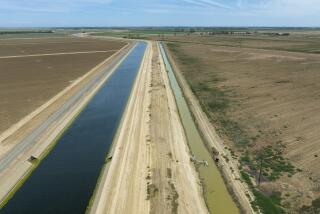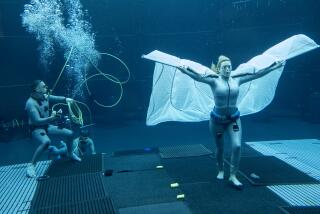His Sense Is to Just Go With the Flow
In most of Southern California, the earth hides its water beneath rock and sand and mountain. When Steve Andrews and Diane Best began to build their house deep in the San Bernardino wilderness, 21 rugged miles from the nearest municipal water tank, they knew theyâd have to dig a well. But, on their square mile of land, where? And how deep?
They asked Bill Cox, a soft-spoken, exceptionally fit octogenarian who has spent the past 35 years finding secret stashes of water in the ground beneath the American Southwest, Canada, Japan, Egypt, Brazil and, mostly, California. He finds it--or dowses--with a stick, his hands or his âaurameter.â
âHe marked the ground and told us where to dig, exactly, and said, âHere. Not 6 inches to the left or right,ââ Andrews recalls. Cox had been hired to dowse a nearby plot and liked their land so much he offered to waive his $600-plus fee. âHe told us weâd have an excellent well, that there was a confluence of three different water courses.â
They had Errol Smith, a well digger based in Big Bear, drill on the spot marked by Cox, and he hit water at 125 feet, 140 feet, and 160 feet. The resulting well yielded 30 gallons per minute, more than twice the amount needed for domestic use. Smith once believed dowsing was quackery, but, he says, after 45 years of drilling heâs seen it work too many times. Dowsing is the ancient art of locating lost or hidden objects, usually water, through heightened intuition or some subconscious connection to waterâs energy--or so its practitioners claim. Cox, 81, calls it âclairsentienceâ--extrasensory touching.
The most common form of dowsing involves a forked switch, which, held lightly in the hands, twitches to indicate a water source beneath the soil. Dowsers, also known as water diviners or water witches, have been practicing for at least 1,000 years in Europe. Many cultures throughout the world have similar traditions.
Coxâs experience of water is intense: half meditation, half vision. He says he feels, sees, tastes and hears the underground water; his aurameter, a flexible steel rod, simply amplifies his senses. Sitting in the living room of his home in the Ojai hills, quiet but for the burble of an ornamental waterfall, Cox recalls one instance: âI was locating a well site, and it was as if [in my mind] I was being lowered down a well shaft with a minerâs cap. I was going down through different levels; I could call out the different strata formations I was seeing. And then the water.â
His English wife, Davina, adds, âHe called out the strata, and I wrote them all down, and when the client drilled the well, Bill had been correct about everything.â
His favorite jobs are âlost causes, when no one else can find water.â He has written nine books, lectures worldwide and is renowned in dowsing circles. He has had more than 400 clients, including schools, water companies and ranches.
He predicts where and how deep the water is, whether it is hot or cold, whether it flows horizontally or vertically, and how many gallons per minute are available. And he does this, he says in his quiet, still manner, with an accuracy rate of 80% to 93%.
Such claims are roundly dismissed by hydrologists and geologists who rely on detailed maps and a kind of underground X-ray called electrical resistivity to detect water, minerals and oil. Bernard W. Pipkin, professor emeritus of earth sciences at USC, finds dowsing very amusing. âThese guys are like Mayberry,â he says, referring to TVâs âThe Andy Griffith Show.â
âWhatever success they have is based on local knowledge. These guys know the land and where water is most likely to be found--and some of them are very good,â allows Pipkin. Beyond that, he says, âto believe in dowsing you have to have a willingness to believe in the paranormal. There is nothing scientific about what they do.â
A 1986 study of dowsers in Germany reached an ambiguous conclusion. Five hundred self-proclaimed dowsers were asked to pinpoint a water pipe hidden beneath the floor of a barn. Forty-three exhibited exceptional skill, which, the study noted, could not be attributed to mere chance and, âa real core of dowser-phenomena can be regarded as empirically proven.â
Not so, counters Jim Enright, retired professor emeritus of behavioral physiology at UC San Diego. The 43 âskilledâ dowsers were not able to repeat their performance, he points out in a 1999 rebuttal in the Skeptical Inquirer. In fact, he writes, the data was persuasive disproof of the dowsersâ abilities.
But none of this concerns Cox--or the legion of amateur and professional dowsers throughout the world. The American Society of Dowsers in Danville, Vt., has more than 4,000 members and holds conferences and workshops nationwide. Members are a curious mix of old-timers who wander the fields with forked willow sticks, and New Agers who embrace the power of the right brain, the cabala and ESP.
In the early 1960s, then a writer and musician in Santa Barbara, Cox was asked to co-write a book on dowsing with a respected California practitioner, Verne Cameron. âI had no intention of dowsing myself,â says Cox. âIt sounded like someone dropping off to sleep.â
The two spent time in the field, and, when Cameron became weak from cancer, Cox carried him on his back. He was impressed with Cameronâs talent; then one day, Cox arrived late at a site and Cameron asked him what he thought. âI took [the aurameter] and said, âIt looks like 11 gallons a minute at 225 feet and 96 degrees.â I had the figures almost spot on.â When Cameron died shortly thereafter, Cox took over his client list.
Cox has also expanded on Cameronâs theory of âprimary water,â which states that heat and geochemical action in and above the Earthâs magma create water, which is urged upward as steam through seismic faults and rock fissures. This water, produced inside the Earth, Cox says, is totally independent of climate changes, and therefore perpetual.
âImpossible,â says professor Pipkin. âThere is water, but it gets tied up with minerals. It would never be potable by the time it reaches the surface.â
But for Cox and his wife, the line between possible and impossible cannot be so definitively drawn. A few years ago, Cox was hired by a school on Awaji Island in western Japan to locate a new well because the water in the schoolâs existing well was heavily contaminated by iron and barely potable.
Jitso Tanagi, chairman of the board of directors for Yanagi Gakuen Schools, says he was initially doubtful about dowsing, but more conventional hydrology methods had failed.
Sure enough, Cox found them good water. âWe now not only have a constant and stable supply of good water, which doesnât depend on meteorological conditions,â says Tanagi, âbut through Mr. Cox, we have also become reacquainted with the bountifulness of nature.â
The school built a 5-by-5-foot monument over their treasured well in honor of Cox and his wife. Tanagi notes, âWe learned from Mr. and Mrs. Cox of the wonderful potential of the human senses and the human brain.â


